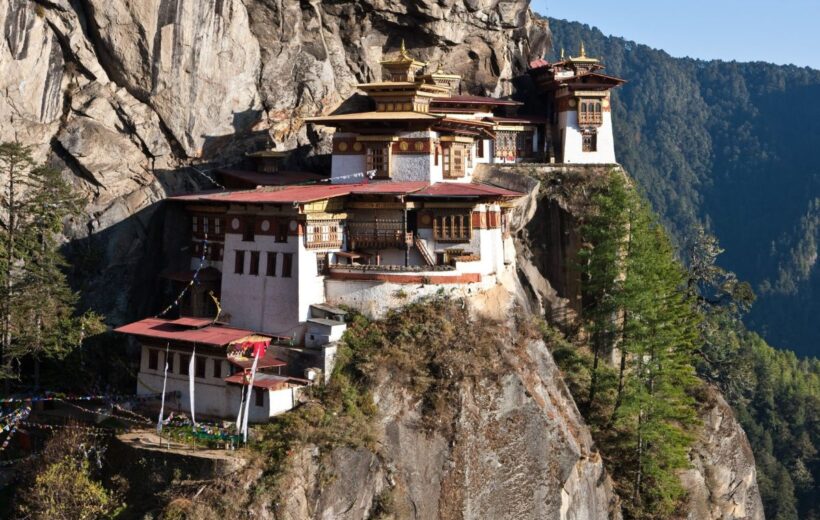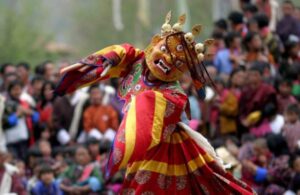The Druk Path finishes at the Bhutan Broadcast Service (BBS) Telecommunication Tower, offering a great view of the city of Thimphu.
Overview
The six day trek is the most popular trek in the country as it passes through a gorgeous natural landscape of blue pine forests, high ridges and pristine lakes while at the same time offering the opportunity to visit some ancient lhakhangs, dzongs and villages.
The Druk Path Trek is also a fairly easy hike to undertake as the distances between rest camps is fairly short. The trail takes you through forests of fir, blue pine and dwarf rhododendrons at altitudes ranging between 2400-4200 m. On the third day hikers will arrive at Jimiling Lake, whose crystal clear waters are home to gigantic trout.
This trek also offers hikers stunning views of Mt. Gangkar Puensum, the highest unscaled peak in the world. The best times to embark on the Druk Path Trek are between March-June or September-November.
| Max Elevation | 4,200 m |
| Min Elevation | 2,400 m |
| Difficulty | Medium |
| Season | March, April, May, June, September, October, November |
| No. of Days | 7 Days |
Included
- Accommodation on Double/ Twin Sharing Basis
- Accommodation in twin sharing basis
- Meal Serve in Hotel as per hotel fix menu basis.
- Exclusive Vehicle for transfers & sightseeing.
- Vehicle will be available as per itinerary only. Not at disposal. 9am-5pm.after 5 pm extra charges apply.
- Base category room used in the package.
- All hotel taxes etc.
- English speaking GUIDE AND driver throughout the tour. Only Bhutan part.
- One Local Sim card.
- One ltr mineral water bottle during sightseeing time only.
Excluded
- Tipping
- Personal Insurance
- Any personal consumption made which is not included in the package
- Alcoholic drinks and special non Alcoholic cocktails, non-alcoholic beverages, aerated drinks and non-aerated drinks.
- Laundry charges at hotel stays
- Entrance fee at the historical monuments.
Tour Plan
Day 1: Paro – Jili Dzong
The first day can be quite arduous as you have to climb more than 1,000m elevation. You start from the Ta Dzong (National Museum) in Paro. The trek follows a gravel road past a few farms for about 30 minutes and then climbs up a steep ridge before leading through blue pine and fir forests to Damche Gom. Once you reach the ridge below Jili Dzong you descend about 100m to the campsite below the Dzong.
Day 2: Jili Dzong – Jangchulakha
You begin with a steep climb for about an hour and a half, then the slope evens a bit and the ascent is more gradual. The trail takes you through thick alpine forests and dwarf rhododendron trees. You may see herders and their yaks around your campsite.
Day 3: Jangchulakha – Jimelang Tsho
The trail follows the ridge and on a clear day the view of the mountains and valleys are simply stunning. The campsite is close to the Jimgelang Tsho Lake. This lake is known for its giant sized trout.
Day 4: Jimgelang Tsho – Simkotra Tsho
The trail takes you through dwarf rhododendron trees and past Janetso Lake. You may come across some yak herder camps where you will have the opportunity to get a glimpse of a nomad’s life. The campsite is close to Simkotra Tsho Lake.
Day 5: Simkotra Tsho – Phajoding
The day begins with a gradual climb. If the weather permits, you will have a spectacular view of Mount Gangkar Puensum, the highest mountain in Bhutan and several other Himalayan peaks. From this pass, the trek takes you downhill towards Phajodhing where you will halt for the night. The camp is located just above Phadjoding Monastery.
Day 6: Phajoding – Mothithang
After passing Phadjoding monastery, the trek to Thimphu (Mothitang) is downhill through a forested area of mostly blue pine. The walk, at a leisurely pace, takes about three hours.
Day 7: Druk Path – Finish
Frequently Asked Questions
Bhutan is a year-round destination. There are four seasons: summer (June to August), autumn (September to November), winter (December to February) and spring (March to May). But because of the range of altitudes in the country, and the influence of the north Indian monsoons, the climate is incredibly varied.
In the south, the humid, subtropical climate is fairly consistent year-round, with temperatures between 15oC and 30oC. Central Bhutan, with its temperate forests, has a more seasonal climate, with warm summers and cool, dry winters. The northern regions are much colder during winter. Because of the high altitude, mountain peaks are snowy year-round and the lower reaches remain cool in summer.
In summer, the Indian monsoon season runs from late June or July to late September, mostly affecting the southern regions. Most farming activities take place in the summer, when crops thrive in verdant landscapes.
Autumn, from late September or early October to late November, follows the rainy season. It is characterised by bright, sunny days and some early snowfall at higher elevations. It’s the season of feasts and festivals as farmers reap the fruits of their work.
From late November until March, the crisp, clear and sunny winter sets in, with frost throughout much of the country and snowfall common above elevations of 3,000 metres. The winter northeast monsoon brings gale-force winds at the highest altitudes through high mountain passes, giving Bhutan the name Drukyul, which means Land of the Thunder Dragon in Dzongkha (Bhutan’s national language).
Bhutan’s generally dry spring starts in early March and lasts until mid-April. It is a botanist’s delight, with nature in full bloom. Summer weather commences in mid-April with occasional showers and continues to late June.
Visitors of all nationalities, except those from India, require a visa before entering Bhutan. For all visitors, except those from Bangladesh and the Maldives, this visa must be applied for and approved in advance of travel. Visitors from Bangladesh and the Maldives also require a visa, but this can be applied for and approved either in advance of travel or upon arrival in Bhutan.
Visitors from India are able to apply for a permit but are required to hold an Indian passport or an Indian voter ID card. For Indian nationals under the age of 18, a passport or a birth certificate can be used to enter and they must be accompanied by a legal guardian.
Nationals from Switzerland and Thailand holding diplomatic or government-official passports are eligible for a visa at their port of entry.
A correctly input visa application can take up to five days to process.
The Sustainable Development Fee (SDF) is a daily levy paid by visitors to support Bhutan’s development. Since the kingdom first opened its doors in 1974, guests have played a critical role in our country’s growth.
The SDF is collected by the national exchequer and funds are allocated to various projects that create long-term, sustainable opportunities for the Bhutanese people, through free healthcare, education and training, upskilling the tourism and hospitality industry, improved infrastructure, environmental preservation and conservation, cultural preservation programmes and initiatives that support local businesses and economies. The SDF is also a vital means of maintaining the exceptional forest cover and carbon-neutrality for which our small nation is world-renowned and globally critical. The SDF also helps us to ensure that we can continue to offer guests tranquillity and an intimate experience.
The SDF is USD 100 per night for adults from all countries except for India. Children aged between 6 years and who have not yet turned 12 are eligible to pay USD 50 per night. Children who have not yet turned 6 years old do not have to pay any SDF.
The SDF for Indian nationals (showing a valid Indian passport or Voter ID card) is Nu. 1,200 (or the equivalent amount in Indian rupees) per person, per night. Children aged between 6 years and who have not yet turned 12 are eligible to pay Nu./INR 600 per night. Children who have not yet turned 6 years old do not have to pay any SDF.








